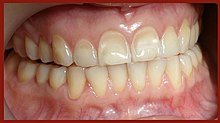**Causes of Dental Erosion:**
– Foods and drinks below pH 5.0-5.7 can initiate dental erosion.
– Extrinsic acid erosion originates from outside the body.
– Acidic foods and drinks lower mouth pH, leading to tooth demineralization.
– Saliva buffers acidic drink pH levels, with fruit juices being the most resistant.
– Medications like chewable vitamin C and aspirin can contribute to erosion.
**Sources of Acidic Erosion:**
– Extrinsic sources include acidic drinks like fruit juices, sports drinks, wine, and colas.
– Fresh fruits, ketchup, and pickled foods in vinegar can cause acid erosion.
– Infants using fruit juice-containing bottles are at risk of acid erosion.
– Certain medications and drugs can lead to acid erosion.
– Intrinsic sources involve gastric acid contacting teeth due to conditions like anorexia, bulimia, and GERD.
**Behavioral Factors Contributing to Acid Erosion:**
– Acid erosion often occurs alongside abrasion and attrition.
– Abrasion is commonly caused by brushing too hard.
– Swishing acidic drinks in the mouth can increase acid erosion risk.
– Sucking citrus fruits can contribute to acid erosion.
– Frothing acidic drinks in the mouth before swallowing raises erosion risk.
**Diagnosis and Detection of Dental Erosion:**
– In-vivo studies directly assess erosion in patients’ mouths.
– Dental erosion signs include appearance changes and sensitivity.
– Tooth color changes, like transparency and yellowish tint, indicate erosion.
– Changes in tooth shape, concavity, and gaps can signal dental erosion.
– Dental indices like BEWE grade tooth wear severity but lack standardization.
**Prevention, Management, and Restoration of Dental Erosion:**
– Individuals should consult medical professionals for GERD symptoms or eating disorders.
– Dental professionals can prescribe neutralizing agents and recommend healthy lifestyle changes.
– Industry should develop effective OTC medications for GERD with fewer side effects.
– Treatment options for erosion range from resin composite fillings to ceramic crowns.
– Long-term success requires addressing the causes of acid erosion and combining active treatment with preventive measures.
Acid erosion is a type of tooth wear. It is defined as the irreversible loss of tooth structure due to chemical dissolution by acids not of bacterial origin. Dental erosion is the most common chronic condition of children ages 5–17, although it is only relatively recently that it has been recognised as a dental health problem. There is generally widespread ignorance of the damaging effects of acid erosion; this is particularly the case with erosion due to consumption of fruit juices because they tend to be considered as healthy. Acid erosion begins initially in the enamel, causing it to become thin, and can progress into dentin, giving the tooth a dull yellow appearance and leading to dentin hypersensitivity.
| Acid erosion | |
|---|---|
| Other names | Dental erosion |
 | |
| An example of severe dental damage due to acid erosion. | |
| Specialty | Dentistry |
| Complications | Oral infection, tooth decay, tooth loss, xerostomia |
The most common cause of erosion is by acidic foods and drinks. In general, foods and drinks with a pH below 5.0–5.7 have been known to trigger dental erosion effects. Numerous clinical and laboratory reports link erosion to excessive consumption of such drinks. Those thought to pose a risk are soft drinks, some alcohol and fruit drinks, fruit juices such as orange juice (which contain citric acid) and carbonated drinks such as colas (in which the carbonic acid is not the cause of erosion, but citric and phosphoric acid). Additionally, wine has been shown to erode teeth, with the pH of wine as low as 3.0–3.8. Other possible sources of erosive acids are from exposure to poorly regulated chlorinated swimming pool water, and regurgitation of gastric acids. In children with chronic diseases, the use of medicines with acid components is a risk factor too. Dental erosion has also been recorded in the fossil record and was likely caused by the consumption of acidic fruits or plants.
